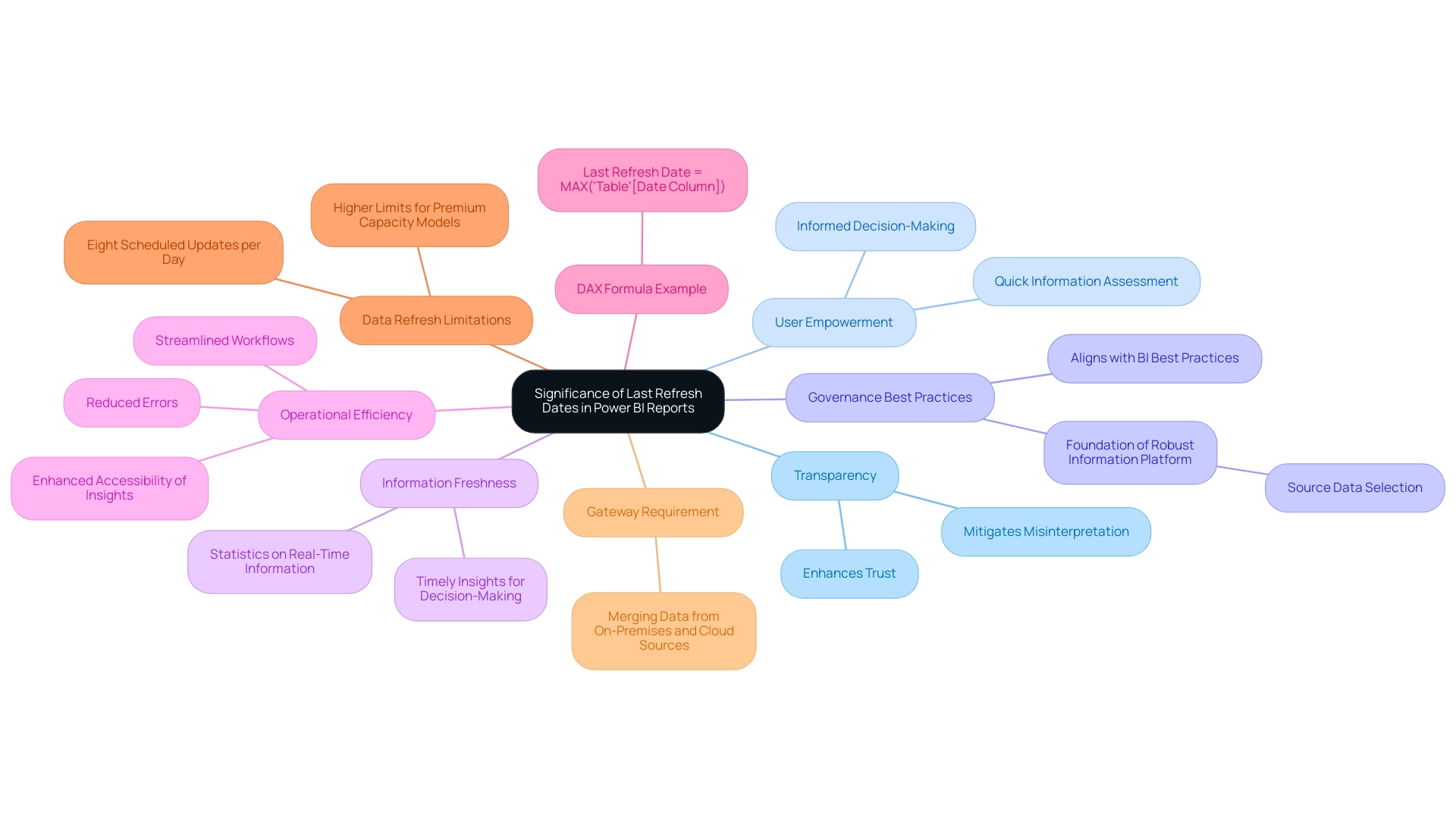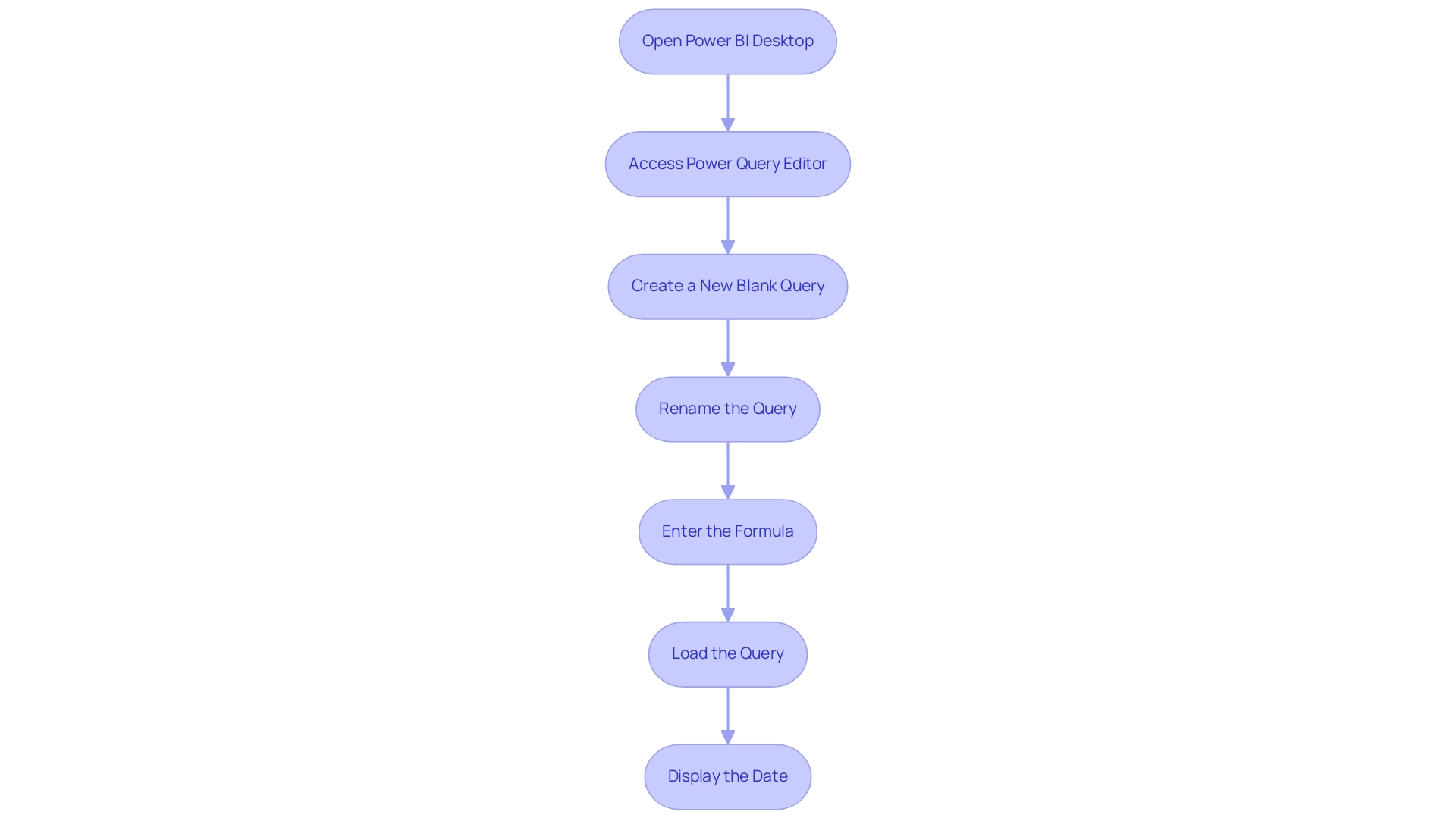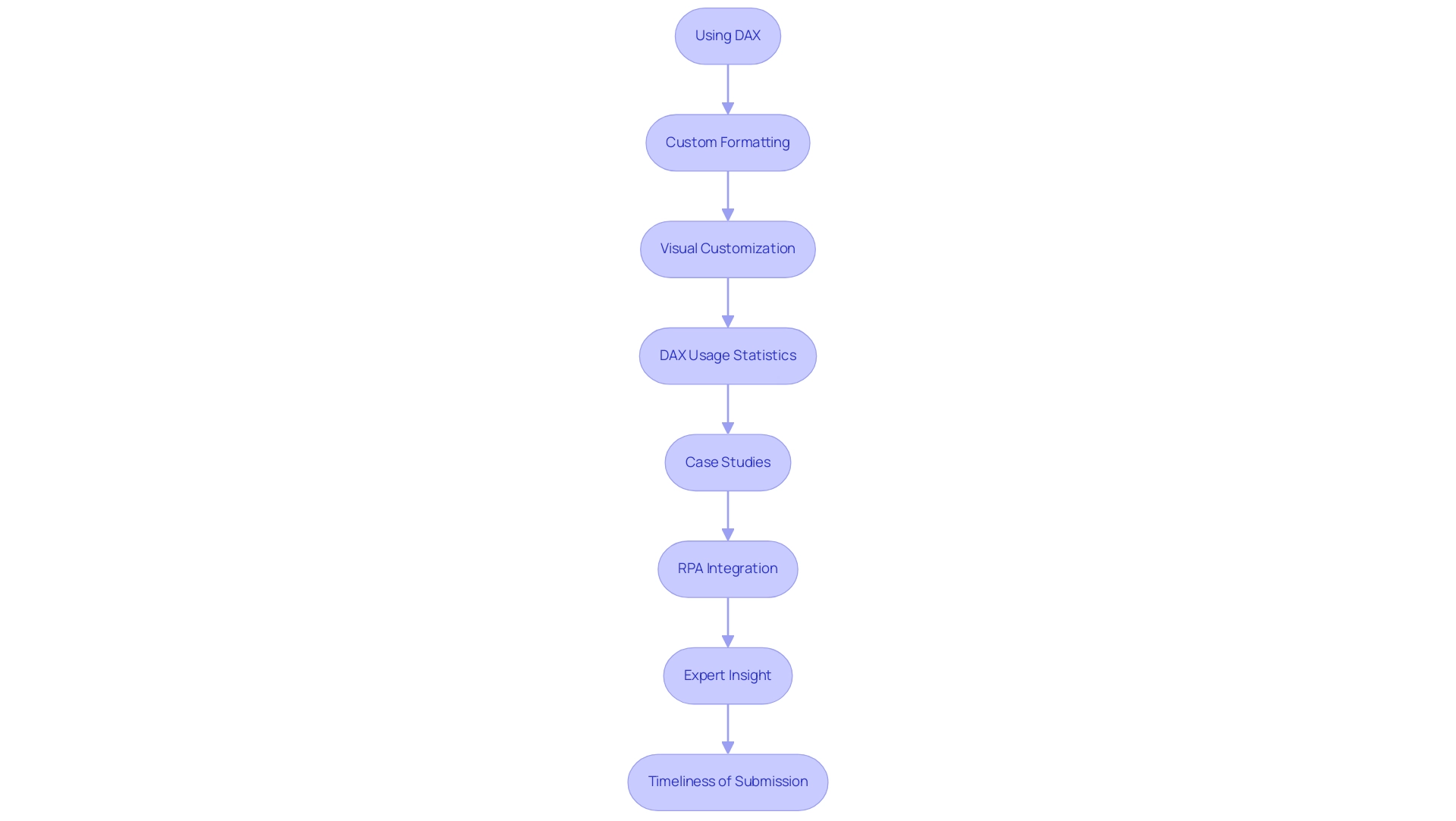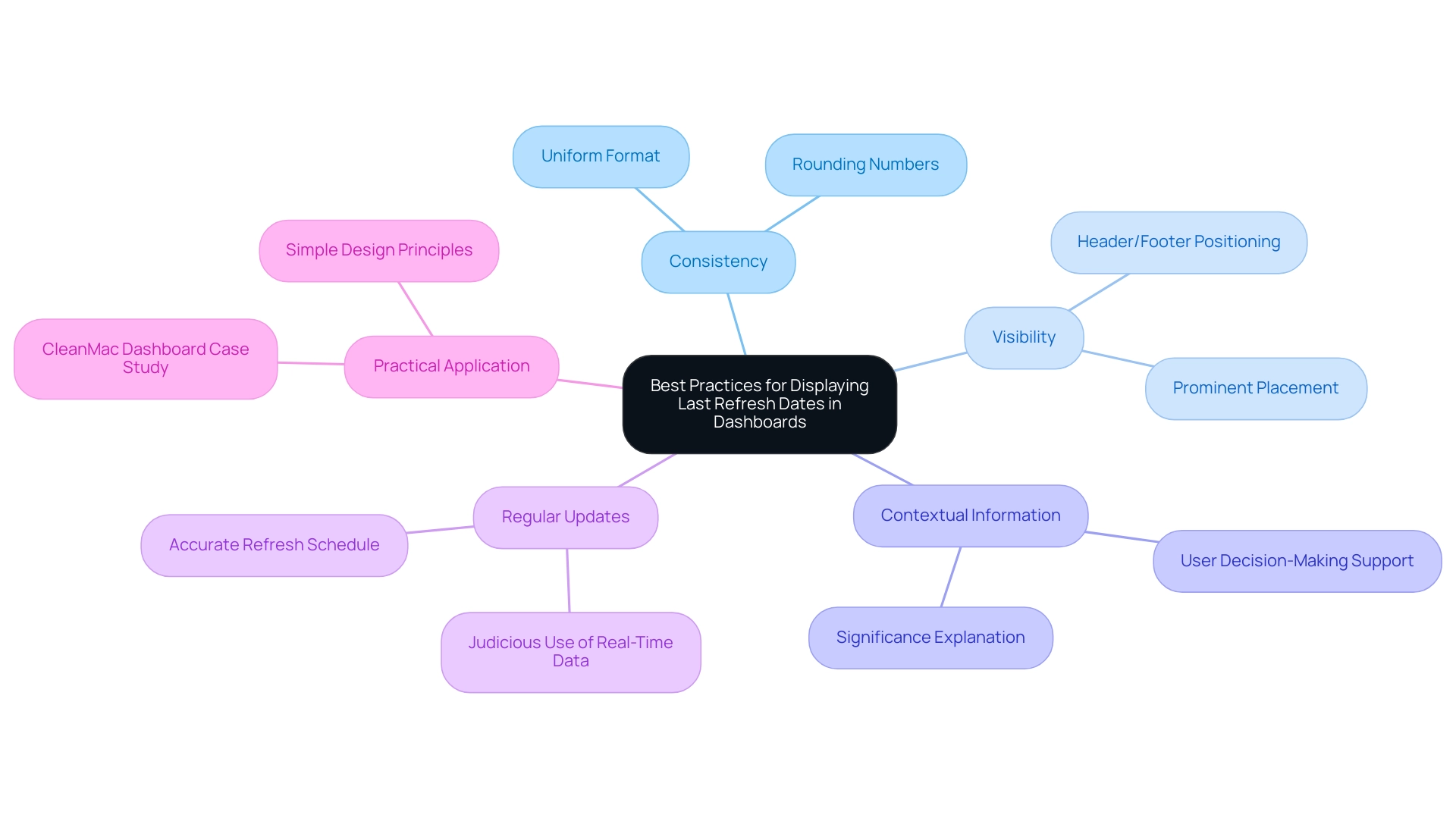Overview
Incorporating the last refresh date into a Power BI report is essential for enhancing transparency and enabling users to quickly ascertain the currency of the data they are viewing. This practice not only builds trust in decision-making processes but also adheres to best governance practices. Ultimately, it leads to improved operational efficiency and fosters more informed strategic discussions.
Introduction
In the dynamic landscape of business intelligence, the significance of data freshness is paramount. As organizations increasingly rely on Power BI for their reporting needs, the last refresh date becomes a critical element that enhances transparency and fosters trust in the decision-making process. By clearly displaying this vital information, users can swiftly assess whether the data is current or outdated, minimizing the risks associated with relying on stale insights.
This article explores the importance of last refresh dates in Power BI, providing practical guidance on effective implementation and display. It addresses common challenges and outlines best practices for maximizing operational efficiency. With the right strategies in place, organizations can leverage real-time data to drive informed decisions and maintain a competitive edge in their respective industries.
The Significance of Last Refresh Dates in Power BI Reports
In Power BI, adding the last refresh date to reports is essential as it serves as a crucial indicator of information currency, directly impacting decision-making processes. By prominently displaying this date, organizations can significantly enhance transparency and foster trust in their reports. Users are empowered to quickly ascertain whether the information reflects the latest updates or if it is outdated, thus mitigating the risks of misinterpretation that can stem from relying on stale information.
This practice not only enhances the user experience but also aligns with established best practices in governance, which is crucial for leveraging Business Intelligence effectively.
The significance of information freshness in business intelligence cannot be overstated, particularly in 2025, where timely insights are crucial for strategic decision-making. Statistics indicate that organizations utilizing real-time information are significantly more likely to make faster decisions than those relying on outdated details. Our Power BI services, featuring the 3-Day Power BI Sprint and the General Management App, enable the swift production of professionally crafted documents, ensuring that information is not only up-to-date but also actionable.
The DAX formula for displaying the Last Refresh Date can be utilized as follows: Last Refresh Date = MAX('Table'[Date Column]). Moreover, a case study on information update limitations in Power BI emphasizes that models on shared capacity are limited to eight scheduled updates per day, highlighting the importance of effective scheduling to optimize information updates based on operational requirements.
To support governance and improve the overall quality of insights obtained from Power BI, it is essential to add the last refresh date to the report. By ensuring that users are aware of the currency of the information, organizations can enhance their decision-making processes, ultimately driving better outcomes. Expert opinions emphasize that the foundation of a robust information platform lies in the careful selection and management of source information, which is essential for accurate reporting and analysis.
As Paul Turley, Microsoft Data Platform MVP, states, “For the platform, the foundation is the selection of source information that are shaped, cleansed and transformed for reporting and analysis.” Thus, the final update timestamp serves as a crucial element in preserving the integrity and reliability of business intelligence initiatives. Moreover, it is crucial to highlight that a gateway is necessary for merging or appending data from on-premises and cloud sources, which further enriches the conversation on data integration and update techniques.
By leveraging RPA and tailored AI solutions, organizations can streamline their workflows, reduce errors, and ultimately enhance operational efficiency, making data-driven insights more accessible and actionable. Book a free consultation with Creatum GmbH to learn more about how our solutions can benefit your organization.

Step-by-Step Guide to Adding Last Refresh Dates
To effectively incorporate the last refresh date into your Power BI report and harness automation for enhanced operational efficiency, follow these detailed steps:
- Open Power BI Desktop: Launch the application and access the document you wish to modify.
- Access Power Query Editor: Navigate to the ‘Home’ tab and click on ‘Transform Data’ to open the Power Query Editor.
- Create a New Blank Query: Within the Power Query Editor, select ‘Home’ > ‘New Source’ > ‘Blank Query’ to initiate a new query.
- Rename the Query: Right-click on the newly created query and rename it to ‘Last Refreshed Date’ for clarity.
- Enter the Formula: In the formula bar, input the following formula:
= DateTime.LocalNow(). This command records the present moment and time, ensuring your document reflects the latest update. - Load the Query: Click ‘Close & Apply’ to bring the query back into your document, making the last update time available for display.
- Display the Date: To visualize this information, add a card visual to your document and select the ‘Last Refreshed Date’ measure to showcase it prominently.
Including the option to add the last refresh date to your Power BI report not only enhances the clarity of your documents but also sustains operational efficiency by enabling users to swiftly determine the relevance of the information provided. Best practices suggest that to significantly improve user trust and engagement with the report, it is crucial to add the last refresh date. Furthermore, administrators can monitor scheduled update events and their durations to prevent resource contention, ensuring a smooth update process.
To further elevate operational efficiency, consider integrating Robotic Process Automation (RPA) to automate the information update process. RPA minimizes manual intervention, reduces errors, and frees your team for more strategic tasks, effectively addressing the challenges posed by manual, repetitive tasks in Power BI reporting. It is important to note that a semantic model can only utilize a single gateway connection, which may impact how you manage your data refreshes.
For advanced techniques, consider utilizing Power BI APIs to track update status. By invoking the update APIs, you can receive a JSON response detailing the success or failure of the last update, which can be processed using Python scripts to maintain an ongoing check on your datasets. This method can significantly enhance your documentation capabilities and align with best practices for creation and management.
By adhering to these steps, you will successfully incorporate a dynamic last update timestamp into your Power BI analysis, emphasizing the significance of efficient information management and the role of RPA in attaining operational effectiveness. The case study titled ‘Business Intelligence Empowerment‘ illustrates how organizations can drive growth and innovation by enhancing information quality and simplifying AI implementation, highlighting the critical intersection of Business Intelligence and RPA in fostering insight-driven decisions.

Techniques for Displaying Last Refresh Dates: DAX and Customization
Incorporating the last refresh date into your Power BI report significantly enhances usability and clarity, especially in environments where data-driven insights are crucial for operational efficiency and business growth. However, challenges such as poor master data quality and barriers to AI adoption can impede effective reporting. Here are several effective techniques to achieve this:
-
Using DAX: Develop a measure using DAX to capture the last update timestamp. A straightforward yet powerful formula is
Last Refresh = NOW(). This measure updates automatically with each refresh, ensuring users always access the most current information, which is vital for informed decision-making. -
Custom Formatting: After establishing the measure, format it for clarity and user-friendliness. Depending on your reporting needs, you may choose to display just the day or include the time. This flexibility allows you to tailor the presentation to your audience’s preferences, addressing the common challenge of time-consuming document creation.
-
Visual Customization: Leverage Power BI’s extensive visual styling options to enhance the display of the last update. Adjusting font size, color, and background can make this information more prominent, capturing viewers’ attention. For instance, using a contrasting color for the last update can help it stand out against the document’s background, improving the overall user experience.
-
DAX Usage Statistics: As of 2025, DAX continues to be a powerful tool within Power BI, with an increasing number of users utilizing its capabilities to enhance reporting. Notably, there are over 60 videos in the Microsoft Fabric series that offer valuable resources for learning DAX and Power BI techniques, informing how you implement these strategies effectively.
-
Case Studies: Organizations that have adopted these DAX techniques report improved decision-making capabilities. For example, a recent case study titled “Business Intelligence Empowerment” highlighted how a company modified its reporting to include the last refresh date in its Power BI report, leading to more informed strategic discussions and overcoming obstacles to AI adoption.
-
RPA Integration: Implementing RPA solutions can further enhance operational efficiency by automating document generation and ensuring information quality. By automating repetitive tasks, organizations can minimize the time spent on report creation and focus on deriving actionable insights from their data.
-
Expert Insight: As noted by Douglas Rocha, a statistics enthusiast, “Even though one can assume it is the simplest of all statistical measures since it is only the most common value in the dataset, there isn’t a native DAX function to calculate it.” This underscores the intricacies of DAX and highlights the importance of understanding its functionalities when displaying the last update.
-
Timeliness of Submission: It is also crucial to recognize that usage metrics documents cannot be added to apps and do not appear in Recent Workspaces or Favorites, which is relevant to the context of Power BI analysis and emphasizes the challenges of ensuring data consistency.
By employing these methods and integrating RPA solutions, you not only ensure that the final update timestamp is operational but also enhance the overall visual appeal of your Power BI displays, making them more engaging and informative for stakeholders, ultimately fostering growth and innovation.

Troubleshooting Common Issues with Last Refresh Dates
Incorporating last refresh dates into Power BI reports presents users with several common challenges that can undermine the accuracy and visibility of this vital information:
-
Date Not Updating: A frequent issue arises when the last update date does not change. To resolve this, confirm that the query is configured to update alongside the report. Reviewing the update settings within Power BI Service is essential, as improper configurations can result in outdated information being displayed. Additionally, users should be aware that Microsoft only supports the last six versions of the on-premises information gateway, which may limit update capabilities.
-
Permission Issues: Access rights are crucial for information visibility. Users may encounter problems if they lack the necessary permissions to access the information source, hindering the accurate display of the update timestamp. It is advisable to verify user permissions and ensure that all access rights are appropriately assigned to enable seamless data refreshes.
-
Visual Overlap: The layout of the report can significantly impact the visibility of the latest update. If this information is obscured by other visuals, adjusting the report’s design is imperative. Establishing a dedicated area for the last refresh date not only enhances visibility but also improves the overall user experience.
-
Common Issues with Update Timings: In 2025, users reported various problems related to update timings, such as discrepancies in expected update intervals and failures in planned updates. Understanding these prevalent issues can facilitate proactive troubleshooting, especially in an information-rich environment where poor master information quality can lead to ineffective operations and erroneous decision-making.
-
Expert Insights: Industry specialists emphasize the importance of maintaining clear visibility of refresh dates to ensure information integrity. As noted by Jeff Shields, an industry expert, “I wonder if you could ZIP them and read them into a dataflow from a OneDrive/SharePoint folder.” Addressing these issues promptly can prevent larger governance challenges, particularly as organizations seek to leverage AI and automation for improved operational efficiency while ensuring the last refresh date is included in Power BI reports.
-
Case Study: A relevant case analysis highlights the use of sensitivity labels in categorizing information, aiding in the management of sensitive material while enhancing governance and compliance. This approach underscores the significance of efficient information management in Business Intelligence, illustrating how proper handling of information can improve the overall management of refresh dates and report quality. By implementing sensitivity labels, organizations can ensure the appropriate handling of sensitive material, crucial for maintaining data quality and overcoming barriers to AI adoption.
-
Additional Resources: Microsoft Power BI provides a training module for managing semantic models, enabling users to create multiple outputs from a single model and reduce administrative overhead. Leveraging these resources can further enrich the Power BI experience and enhance the management of update schedules.
By identifying these frequent challenges and applying the recommended solutions, users can effectively resolve issues and maintain the accuracy of their Power BI documents, ensuring that the most recent update is both visible and reliable. This proactive approach not only enhances operational efficiency but also positions organizations to better harness the power of Business Intelligence.

Best Practices for Displaying Last Refresh Dates in Dashboards
To effectively display the last refresh date in your Power BI dashboards, adhere to the following best practices, which are crucial for leveraging Business Intelligence and RPA to drive operational efficiency:
-
Consistency: Maintain a uniform format for the last update across all reports. This not only enhances the professional appearance of your dashboards but also fosters user familiarity, essential for effective data interpretation. Rounding numbers, such as displaying the last update in a simplified format, can enhance visual effectiveness.
-
Visibility: Place the most recent update prominently within the dashboard, preferably in the header or footer. This strategic placement ensures that users can quickly locate this critical information, thereby improving their overall experience. As Sarah Shaar, an in-house content writer, notes, “Dashboards need to communicate the most important information for the user, in a simple, easy to understand screen.”
-
Contextual Information: Accompany the last update timestamp with contextual details, such as a brief explanation of its significance. This supplementary information assists users in grasping the importance of the update timestamp, greatly improving their decision-making process, particularly in a data-abundant environment where actionable insights are crucial. Addressing challenges like time-consuming report creation and inconsistencies is essential for maximizing the effectiveness of your dashboards.
-
Regular Updates: Configure the refresh schedule accurately to guarantee that the last refresh date reflects the most current information. Be cautious with real-time information; it should be used judiciously to avoid distraction and should be updated periodically for relevance. Regular updates are crucial for preserving the integrity of the information presented, as outdated information can lead to misinformed decisions. Thus, adding the last refresh date to Power BI reports enhances the potential of Business Intelligence tools like EMMA RPA and Power Automate.
-
Practical Application: Consider the design principles illustrated by the CleanMac Dashboard case study, which features a simple design that aids users in understanding data without feeling overwhelmed. This method can be advantageous when showing the last update timestamp, ensuring it is both visible and contextually pertinent.
By implementing these best practices, including ways to add the last refresh date to Power BI reports, you can significantly improve the usability and reliability of your Power BI reports. This ultimately leads to higher user satisfaction and more informed decision-making. Statistics indicate that consistent reporting formats and clear visibility of refresh dates correlate with increased user satisfaction, making these practices essential for effective dashboard design and the successful application of Business Intelligence and RPA solutions. In a competitive landscape, these enhancements can help your business avoid falling behind by ensuring that data-driven insights are readily accessible and actionable.

Conclusion
In the realm of business intelligence, the significance of displaying the last refresh date in Power BI reports is paramount. This essential feature acts as a vital indicator of data currency, enabling users to swiftly assess the relevance of the information presented. By implementing effective strategies for showcasing this date, organizations can enhance transparency and foster trust among users, ultimately leading to improved decision-making processes.
This article explores various techniques for integrating and displaying last refresh dates, from utilizing DAX measures to employing visual customization. Best practices, such as maintaining consistency in formatting and ensuring prominent visibility, are crucial for maximizing the impact of this feature. Furthermore, addressing common challenges and troubleshooting issues related to refresh dates can enhance the reliability of Power BI reports.
By prioritizing the display of last refresh dates and adhering to established best practices, organizations can leverage real-time data to drive informed decisions and maintain a competitive edge. As the business landscape continues to evolve, the ability to provide accurate and timely insights through effective data management will be essential for success. Embracing these principles not only streamlines reporting processes but also empowers teams to focus on strategic initiatives, ultimately contributing to organizational growth and innovation.
Frequently Asked Questions
Why is adding the last refresh date important in Power BI reports?
Adding the last refresh date is crucial as it indicates the currency of the information, impacting decision-making processes. It enhances transparency and trust, allowing users to quickly determine if the information is up-to-date or outdated.
How does the last refresh date affect decision-making in organizations?
The last refresh date helps organizations make informed decisions by ensuring they rely on the most current data. Statistics show that organizations using real-time information can make faster decisions compared to those relying on outdated data.
What is the DAX formula for displaying the last refresh date in Power BI?
The DAX formula to display the last refresh date is: Last Refresh Date = MAX('Table'[Date Column]).
What are the limitations regarding scheduled updates in Power BI?
Models on shared capacity in Power BI are limited to eight scheduled updates per day, making effective scheduling essential for optimizing information updates.
What steps should be followed to add the last refresh date to a Power BI report?
- Open Power BI Desktop and access your document. 2. Navigate to the Power Query Editor by clicking ‘Transform Data’. 3. Create a new blank query and rename it to ‘Last Refreshed Date’. 4. Enter the formula
= DateTime.LocalNow()in the formula bar. 5. Click ‘Close & Apply’ to load the query back into your document. 6. Add a card visual to display the ‘Last Refreshed Date’ measure.
How can Robotic Process Automation (RPA) enhance operational efficiency in Power BI?
RPA can automate the information update process, minimizing manual intervention, reducing errors, and allowing teams to focus on more strategic tasks, thus improving operational efficiency.
What is the role of a gateway in Power BI data integration?
A gateway is necessary for merging or appending data from on-premises and cloud sources, which is vital for effective data integration and updates.
How can Power BI APIs be used to track update status?
By utilizing Power BI APIs, users can invoke update APIs to receive a JSON response detailing the success or failure of the last update, which can be processed using Python scripts for ongoing dataset monitoring.
What expert opinion emphasizes the importance of source information in Power BI?
Paul Turley, a Microsoft Data Platform MVP, states that the foundation of a robust information platform lies in the careful selection and management of source information, which is essential for accurate reporting and analysis.

